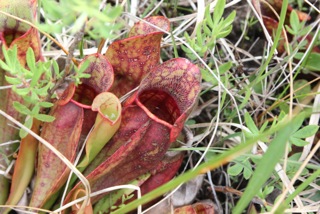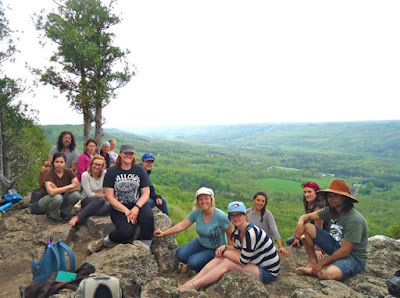The themes of caretaking and stewardship
wove through our June weekend. Our second morning, like our first day, was
grounded at Alexis and Bobbi’s place, home of Earth Tracks Outdoor School and
Rebel Roots Herb Farm.
 We spent the morning in two groups
alternating between two herbal medicine-making activities using common wild
plants. Alexis took a group through the
process of harvesting plantain and making an infused oil, to use on its own or
as a later base for medicinal salve. Lee and I led a second activity,
harvesting some of the abundant wild thyme whose fragrance wafted around our
tents, and creating a thyme-infused medicinal apple cider vinegar. Alex joined in at Alexis’s station to strain
off and share the lemon balm cold infusion she had made the previous day: a
welcome refresher to the morning’s heat. Each group researched the plants while
working with them, using field guides and each other’s knowledge to understand
the medicinal properties of the plants we harvested with our hands.
We spent the morning in two groups
alternating between two herbal medicine-making activities using common wild
plants. Alexis took a group through the
process of harvesting plantain and making an infused oil, to use on its own or
as a later base for medicinal salve. Lee and I led a second activity,
harvesting some of the abundant wild thyme whose fragrance wafted around our
tents, and creating a thyme-infused medicinal apple cider vinegar. Alex joined in at Alexis’s station to strain
off and share the lemon balm cold infusion she had made the previous day: a
welcome refresher to the morning’s heat. Each group researched the plants while
working with them, using field guides and each other’s knowledge to understand
the medicinal properties of the plants we harvested with our hands.
Our afternoon location was a short drive
away: the forested property where Earth Tracks had been based until
recently. The brightness of sun and
openness of the agricultural landscape where we had started the weekend was
transformed into the coolness and cover of dense trees; the industriousness of
the morning’s activities into a grounded and aware exploration of this new
place and its energy.
 We began the afternoon identifying trees on
the property; but quickly moved into several activities that shifted our
awareness to more subtle information around us.
A paired blindfolded “meet a tree” exercise gave each person the
opportunity to use their less dominant senses – including intuition – to get to
know an individual tree and then find it again with the blindfold removed. We followed this with a focused sit spot,
each of us tuning in to the space around us and asking the questions “what can
I do to help?” or “how can I give back to this land?” and listening to the
possible answers: moving branches, lifting up weight, pruning. It was in introduction to listening deeply to
the land as an expression of caretaking.
We began the afternoon identifying trees on
the property; but quickly moved into several activities that shifted our
awareness to more subtle information around us.
A paired blindfolded “meet a tree” exercise gave each person the
opportunity to use their less dominant senses – including intuition – to get to
know an individual tree and then find it again with the blindfold removed. We followed this with a focused sit spot,
each of us tuning in to the space around us and asking the questions “what can
I do to help?” or “how can I give back to this land?” and listening to the
possible answers: moving branches, lifting up weight, pruning. It was in introduction to listening deeply to
the land as an expression of caretaking.
To close the afternoon, we worked on one
more caretaking project, a deer trail that the apprenticeship group of three
years ago had begun clearing. Alexis
spoke of his connection to the deer on this property, where he had hunted as
well as stewarded the land. We moved on to the trail, thinking through the mind
of a deer which obstacles would hinder our progress, especially at low energy
and hungry times of year. As we moved
branches, our intention was also to create brush piles, as we had the day
before, to provide shelter for small mammals and other creatures.
 As I stood on a trail clearing branches
onto a pile beside me, I did not expect what happened next. I lifted a particularly long branch and
dropped it to my right with a small crash.
The crash was followed by several more, the rustling of leaves and the
crashing of small panicked feet. I
looked up to see a small dappled fawn dashing fleetly away from me, looking for
its mother, who would not have been far away.
I was astonished at how well this small creature had been camouflaged
two feet beside me, and shaken to have found myself scaring it in this
way. A few people around me working on
the same trail gathered together to look at the spot where the fawn had been –
a tiny kidney-shaped spot in the earth still warm to the touch. It was a gift to see this fawn, to know that
there were young here needing shelter, and to see that the brush piles we made
would be used exactly as we intended. It
was a powerful experience to walk away with while reflecting on caretaking as
one of the gifts and responsibilities of humans to the Earth.
As I stood on a trail clearing branches
onto a pile beside me, I did not expect what happened next. I lifted a particularly long branch and
dropped it to my right with a small crash.
The crash was followed by several more, the rustling of leaves and the
crashing of small panicked feet. I
looked up to see a small dappled fawn dashing fleetly away from me, looking for
its mother, who would not have been far away.
I was astonished at how well this small creature had been camouflaged
two feet beside me, and shaken to have found myself scaring it in this
way. A few people around me working on
the same trail gathered together to look at the spot where the fawn had been –
a tiny kidney-shaped spot in the earth still warm to the touch. It was a gift to see this fawn, to know that
there were young here needing shelter, and to see that the brush piles we made
would be used exactly as we intended. It
was a powerful experience to walk away with while reflecting on caretaking as
one of the gifts and responsibilities of humans to the Earth.
Written By: Malgosia Halliop - 2nd year
Earth Tracks Wild Plants Apprentice




















